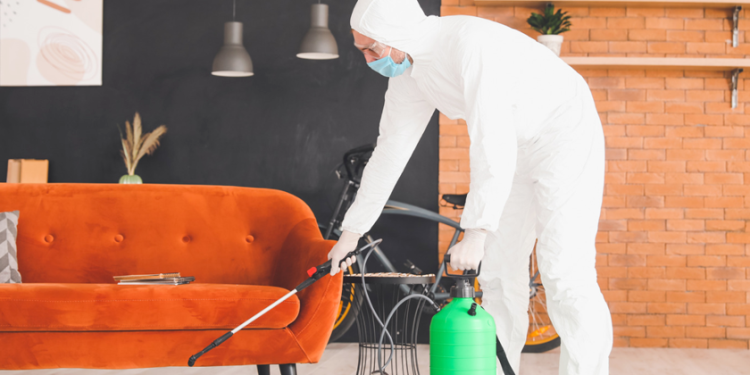Having an infestation of any kind in your home can be a very stressful event. Deciding on the best time to handle the infestation is not always optimal. If time permits, summer is the best time to fumigate your house because the weather is warm and there is plenty of daylight. Disclaimer: Please remember to consult with a professional on fumigation as it can require expertise depending on your situation.
What is Fumigation?
Fumigation is the process of exposing an area to a gas or vapor that kills bugs. The gas or vapor can be a pesticide, such as methyl bromide, or it can be something else, such as carbon dioxide.
When Is the Best Time to Fumigate?
The best time to fumigate is when the weather is warm and there is plenty of daylight. This allows you to open windows and doors to let in fresh air. It also lets you see what you are doing.
Can You Fumigate Inside?
You can fumigate inside, but you need to be careful not to breathe in the gas or vapor. It’s a good idea to wear a mask and gloves when you fumigate and consult with a professional when using any toxic or dangerous solution.
Can Fumigation Be Used to Kill Bed Bugs?
Yes, fumigation can be used to kill bed bugs. In fact, it is one of the best ways to get rid of them.
What Should You Do After Fumigation?
After fumigation, it’s a good idea to stay out of the house for a few hours or the recommended time. This allows the gas or vapor to dissipate. You also need to open all the windows and doors to let in fresh air.
You should also wash all your clothes and bedding in hot water. This will kill any bugs that may be on them.
What are Some Tips for Saving on Fumigation Costs?
1. Ask your pest control company if they offer discounts for multiple treatments.
2. Try to fumigate when the weather is cool or cloudy. This will reduce the cost of the treatment.
3. Find a company that offers a payment plan. This will help you spread out the cost of fumigation over time.
4. Shop around for the best price on fumigation. There are many companies that offer this service.
5. Check with your local government or environmental agency to see if they offer any subsidies or financial assistance for fumigation.
Can I Fumigate my House by Myself?
You can fumigate your house by yourself, but you need to make sure and follow whatever instructions are provided and to not breathe in any of the products used.
Fumigation is a time-consuming process. Chemical fumigation is far more time-consuming than organic fumigation. It necessitates a lot of planning and precision. As a result, the majority of individuals choose to have chemical fumigation done by someone else. Self-fumigating your home, on the other hand, can be a very cost-effective way of getting the job done provided you have the time and knowledge to do it safely.
What are the Types of Fumigation?
Liquid Fumigation
The most popular fumigation method is bagging. A chemical solution or liquid fumigants are used in this technique. The solution is loaded into a spraying device, which is then sprayed over the designated area in measured doses.
Most of these liquid fumigants are:
- Toxic
- Highly inflammable
- Volatile
Outdoor areas or specific enclosed fumigation rooms are ideal for liquid fumigation. They are more successful than solid fumigation in pest control. They’re usually utilized to manage infestations on plants.
Some examples of liquid fumigation are:
- Carbon Disulfide
- Ethyl Acetate
- Chloroform
- Carbon Tetrachloride
- Gas Fumigation
Fumigation may also be done with fumigants in their gaseous state. To do this, you must seal all of the cracks and holes in the area. It is critical to keep the gas confined within the region without allowing it to escape.
Carbon monoxide is another common poisonous gas. It’s also highly toxic, and you must wear protective gear with masks on to prevent any accidental inhalation of the hazardous emissions. Gas fumigation usually employs two types of gases.
Gases for Fumigation:
- Methyl bromide is used for rodent, insect, termite, weed, and nematode control.
- Sulfuryl Fluoride is a pesticide that is used to control insect infestation in tree nuts, dry fruits, and cereal grains.
Solid Fumigation
Solid fumigation is a form of chemical insecticide treatment that employs solid fumigants. These fumigants, which are usually in the shape of tablets, pellets, or powders, are dispersed or strewn in specific areas of your home, including nooks and corners. Solid fumigation has several benefits over liquid and gas.
Benefits
- Less toxic,
- Easier to manage
- Minimum fumigation care
- Not as environmentally invasive.
Solid fumigation, on the other hand, is only effective within a home or other storage area. Liquid and gas fumigation are required for open fields and larger areas, particularly if the infection is serious.
The types of solid fumigants are:
Alum is toxic to humans in high doses. It’s used as a metal treatment, with the active ingredient being aluminum oxide (alum) and sodium silicate. In low doses, it can be absorbed by the body and cause stomach pains or vomiting after ingestion:
Calcium cyanide: This chemically combines with water vapor to form hydrogen cyanide and is used against a variety of pests.
A Note About Organic Options
Natural organic fumigants are a much better alternative than these chemical fumigants since they are safer and more healthy. Natural and organic fumigation chemicals may be produced simply with things that may be found in your kitchen. Not only are they less dangerous, but they’re also quite simple to use.
Conclusion
As we have stated, there are many different options for fumigation which all depend on the severity of the infestation, your knowledge of fumigation, and your budget to solve the problem.


